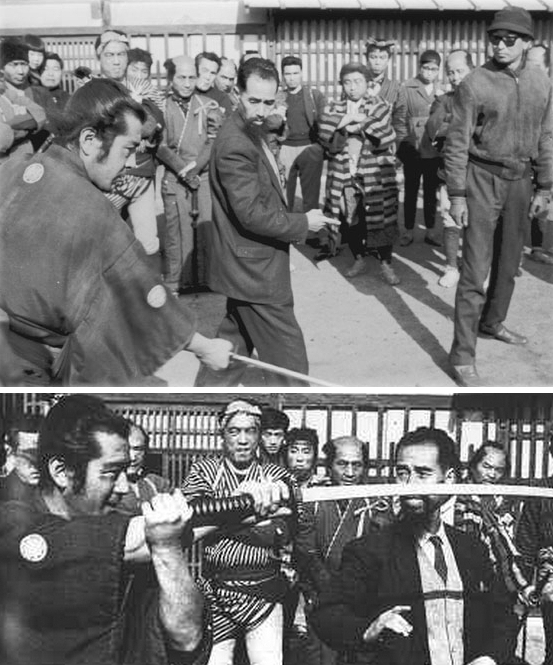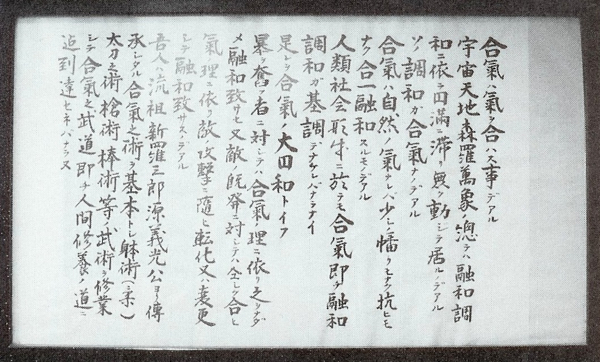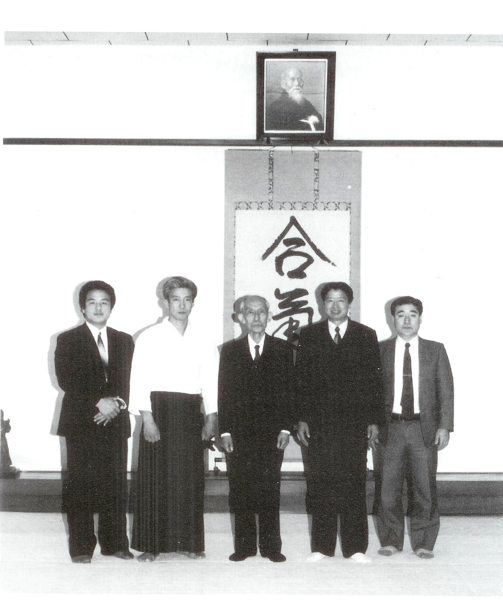Director Akira Kurosawa observes Yoshio Sugino and Toshiro Mifune
on the set of “Yojimbo”, around 1961
Sometimes called “the Last Swordsman”, Yoshio Sugino (杉野嘉男 / 1904–1998) began his martial arts training in Kodokan Judo around 1918.
Becoming dissatisfied with Judo he began to train in traditional Yoshin Koryu jujutsu. Around the same time, in 1927, he also began to train in Tenshin Shoden Katori Shinto-ryu with the four Katori Shinto-ryu shihan dispatched to the Kodokan at the request of Judo Founder Jigoro Kano.
Around 1932 or 1933 he began training with Aikido Founder Morihei Ueshiba, and received a teaching license directly from the Founder in 1935. After the war his Aikido dojo in Kawasaki was the second official branch dojo of the Aikikai (Kuwamori Dojo was the first). Below he talks about his time with O-Sensei and with O-Sensei’s instructor Sokaku Takeda:
I didn’t consider aikido to be just an ordinary art…..Those practicing aikido today say that Ueshiba Sensei was really amazing but also wonder if what he did was actually true or not. They say such a thing because they have never seen his technique directly….I am lucky because I saw Ueshiba Sensei directly.
……………
Although Sokaku Takeda Sensei seemed to have the type of body which could be easily knocked over, his demonstration was extraordinary. He was capable of easily throwing 4th and 5th dan holders of the Kodokan.
– From “Interview with Yoshio Sugino” by Stanley Pranin
Sugino Sensei would later become well known for his work as a choreographer of fight scenes for many famous movies and plays, including Akira Kurosawa’s “The Seven Samurai” and “Yojimbo”.
What follows is an interview with Yoshio Sugino (杉野嘉男) and his son Shigeo Sugino (杉野茂男) that originally appeared in Japanese in “Kengo Retsuden-shu” (Biographies of Kendo Masters) number 67 Futabasha Publishers Ltd. (剣豪列伝集 67号 双葉社 1961年), 1961. This is the same year that the movie “Yojimbo” was released.


![Aiki Budo is de Weg van Menselijke Ontwikkeling [Dutch Version]](https://www.aikidosangenkai.org/blog/wp-content/media/sagawa-scroll_1.jpeg)



